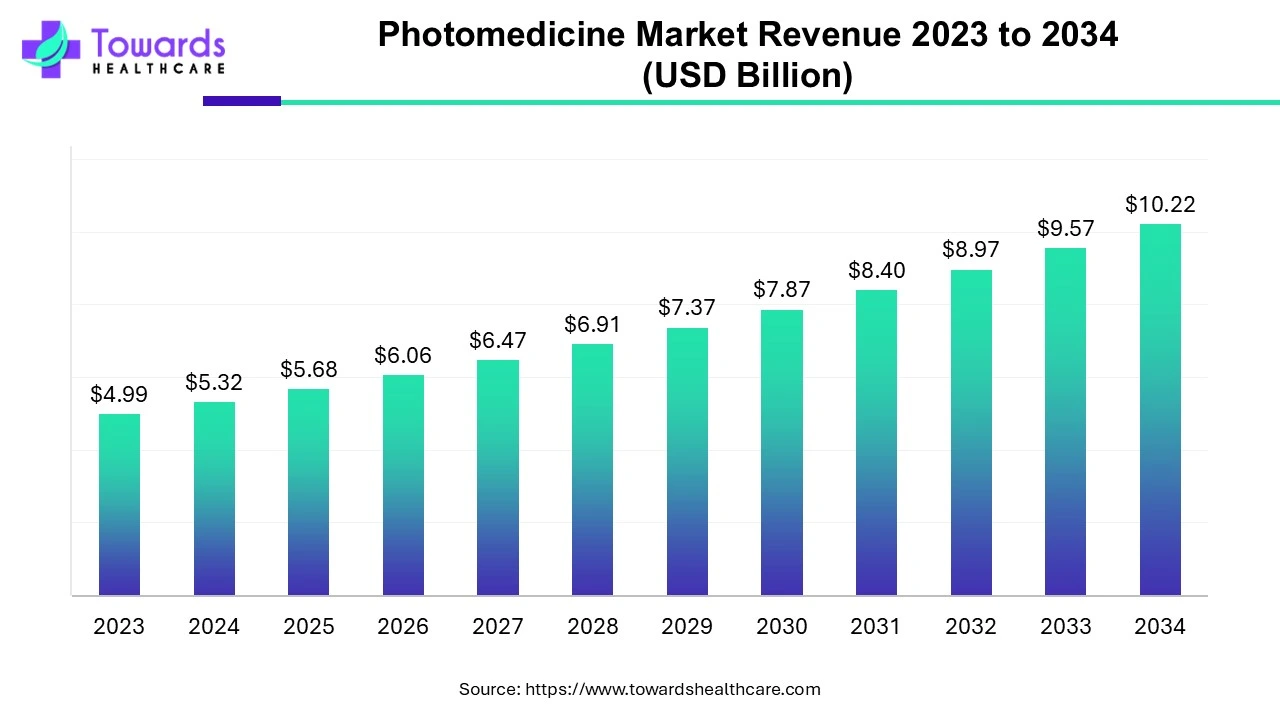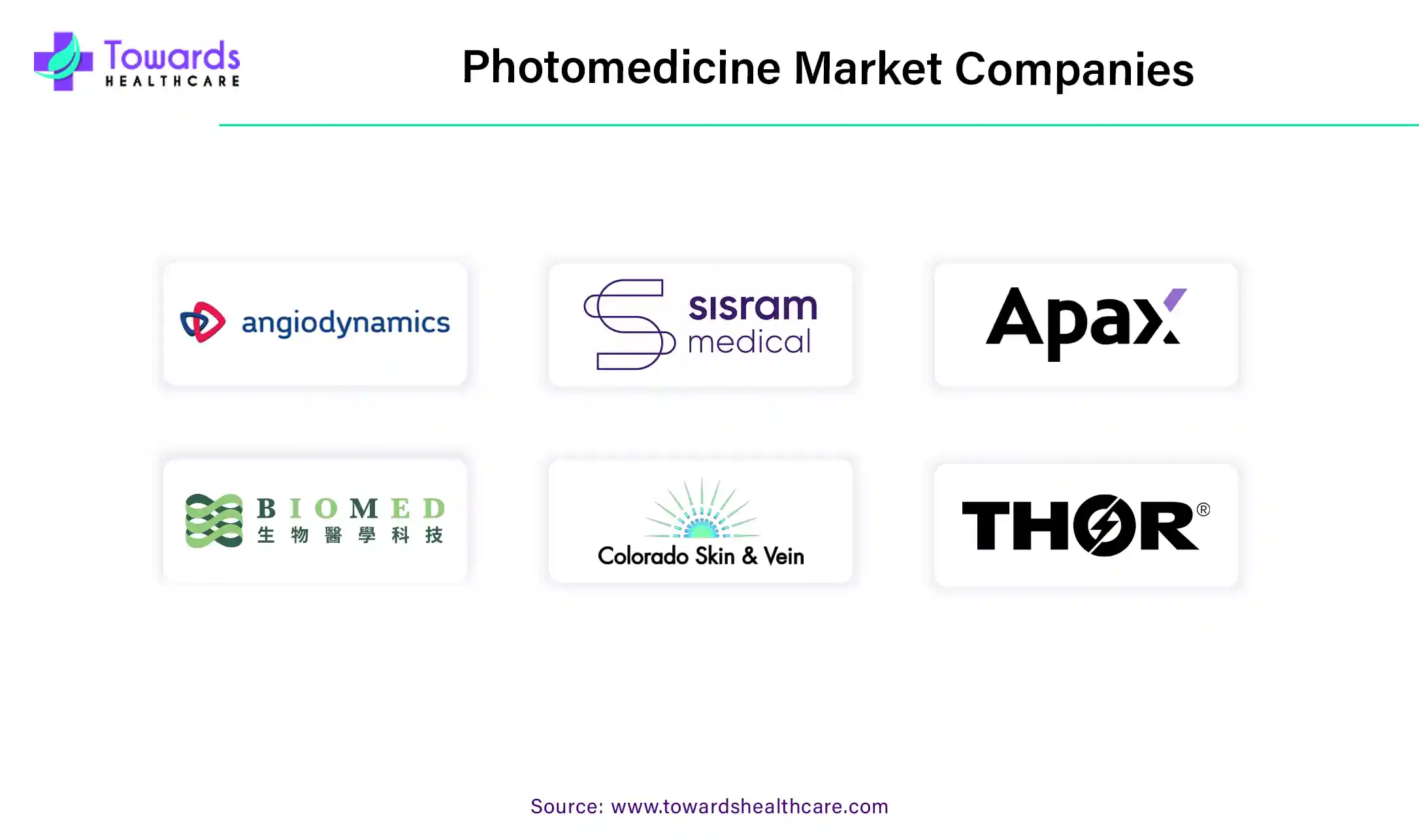January 2025


Principal Consultant

Reviewed By
The global photomedicine market size was estimated at US$ 4.99 billion in 2023 and is projected to grow to US$ 10.22 billion by 2034, rising at a compound annual growth rate (CAGR) of 6.74% from 2024 to 2034. The demand for photomedicine is growing due to the growing need in oncology and dermatology.

Using photons to scan or treat medical conditions is known as photomedicine. Surgery, cardiology, radiology, cancer, diagnostics, medication delivery, dermatology, and ophthalmology are among the medical specialties that might benefit from this multidisciplinary area. We now have a complete understanding of the processes of photodamage thanks to recent developments in photomedicine, such as the identification of delayed formation of CPDs and the physiological effects of visible light.
The effects of ultraviolet (UV) radiation on the immune system, the creation of new photosensitizers for phototherapy, the effects of near-UV radiation on cellular membranes, the role of DNA damage and repair in mutagenesis and carcinogenesis, and the light activation of enzymes as a potential new form of phototherapy are just a few of the ways that photobiology will influence photomedicine in the years to come. The field of photomedicine has a promising future.
When used incorrectly, laser treatment poses the primary hazards of thermal burns and retinal impairment. Whether laser light enters the eye directly or is reflected off of bright objects, it can harm the retina.
North America dominated the photomedicine market in 2023.
Due to elements like a high rate of adoption of cutting-edge medical technology, substantial research and development efforts, and sophisticated healthcare infrastructure. Chronic illness rates are rising in the area, which is driving up demand for cutting-edge photomedicine solutions. The market is also expanding as a result of the aging population and rising demand for minimally invasive procedures. The U.S. dominates the market in North America due to its robust medical technology industry and well-established healthcare system. Canada is a close follower, thanks to its robust healthcare system and high healthcare spending.
Asia Pacific is expected to grow at the fastest rate during the forecast period.
Driven by elements like a growing population, increased rates of chronic illnesses, and rising healthcare costs. Growing middle-class populations in nations like China and India are fueling the need for healthcare, which is why photomedicine technologies are being adopted so quickly. These countries are also making investments in cutting-edge medical facilities and research, which is driving the market's growth. Japan dominates the market thanks to its sophisticated healthcare system, which benefits from a strong focus on medical research and innovation. Photomedicine is expected to continue growing as the Asia-Pacific region embraces its advantages, providing a wealth of prospects for industry participants and improvements in healthcare.
In terms of income from medical aesthetic tourism, Thailand came in fourth place in Asia, after China, Japan, and South Korea, according to Siam Commercial Bank. Among medical tourists, aesthetic medicine is the second most popular medical procedure, behind dental care. Major consumers include both domestic and foreign clients, particularly those from Cambodia, Laos, Burma, Vietnam, and Australia. According to Thailand's Medical Hub Board, the country's medical aesthetics industry is expected to grow three times from its 2020 size to $7.51 billion in 2027. There are 7,000 aesthetic clinics in Thailand, with 5,000 located in various regions and 2,000 in Bangkok.
By technology, the lasers segment held the largest share of the photomedicine market in 2023 and is expected to grow at the fastest rate during the forecast period. Because of their accuracy and precision, lasers enable physicians to perform intricate procedures and create new medical devices and designs for producers. Compared to traditional surgery, laser technology minimizes invasiveness. Most significantly, it lowers the risk of infection and postoperative pain. It is also quicker and more effective.
By application, the ophthalmology segment dominated the market in 2023. Low-level laser therapy, or photobiomodulation (PBM), has gained attention in the ophthalmology community recently as a promising new treatment for a number of retinal conditions, such as retinopathy of prematurity, diabetic retinopathy, Leber's hereditary optic neuropathy, age-related macular degeneration, amblyopia, methanol-induced retinal damage, and possibly others.
By application, the aesthetics segment is estimated to grow at the fastest rate in the photomedicine market during the predicted timeframe. The medical aesthetics industry is very resilient and has the potential for strategic advancements in consumer targeting, product portfolios, and business structures.

The technology developed by CLINUVEL has the potential to upend the skincare industry in addition to the pharmaceutical industry. The company is introducing PhotoCosmetics, a line of cutting-edge skincare products based on a class of peptides called melanocortins, following 43 years of photomedicine research.
By Technology
By Application
By Region
January 2025
December 2024
December 2024
December 2024